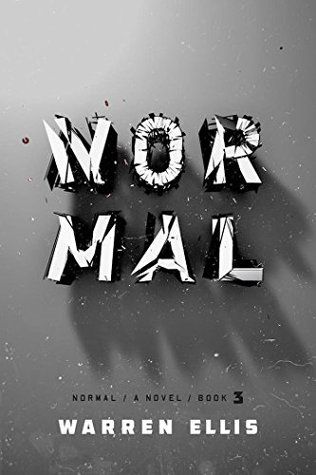Review: Normal by Warren Ellis

Normal opens on a professor threatening an orderly with a shank made from a ten-dollar toothbrush, demanding the entire internet in exchange for his safety—a clear affirmation that the novel’s title should not be taken at face value. This is Normal Head, a mental rehabilitation facility in the forests of Oregon catering to an exclusive clientele: futurists who gazed into the abyss until their minds could no longer bear the strain. We enter the facility with its newest patient, Adam Dearden, a foresight strategist who saw something during a protest in Namibia that shook him so badly he came away with a bad case of “abyss gaze.”
Adam quickly finds himself in the company of Lela Charron, an urbanist, and Clough, an economist, who serve as his guides into the dualistic social structure of Normal Head. On their side are the foresight strategists—nonprofit-funded civil futurists who think about geoengineering and smart cities—and on the other are the strategic forecasters—government- and corporate-funded “spook futurists” who specialize in geopolitical upheaval and drone warfare. Both sides are deeply invested in the possibility of global catastrophe and evading or preparing for it. Both sides comprise, as the acerbic Director of Normal Head indelicately puts it, “all completely mad people who who mess around with technology and weird social theory until [their] brains shit themselves and [they] fall over.” When a mysterious patient disappears, leaving behind only a black mass of insects, Adam must navigate both sides of the aisle—as well as his unstable mental state—to get to the bottom of it.
Warren Ellis is primarily known for his prolific work in comic books, penning cult series like Transmetropolitan and Global Frequency along with mainstream titles like Astonishing X-Men. He has also written two bestselling hardboiled detective novels—2007’s Crooked Little Vein and 2013’s Gun Machine—and become a fixture at technology, philosophy, and futurism conferences. Normal reads like a perfect cross-section of his work, fusing the tech jargon and paranoia of futurism with noir-ish mystery and rendered in direct prose reminiscent of his comic scripts.
The compact novel races through its 148 pages at a breakneck pace, propelled forward by the dual, intertwining mysteries of the disappeared patient and Adam’s shadowy background. Ellis dispenses with narratorial exposition almost entirely, leaving large blanks for his characters to fill in as the plot progresses, and keeps things lively with short sentences and succinct, often funny descriptions; Lela is introduced as having “cruel eyes and a kind smile,” and Clough has “a face like a mallet and skin like a map of Yorkshire scratched out in gin-broken veins.” The supporting characters quickly take on lives of their own, divulging histories, theories, and personal quirks in brisk, believable dialogue. Ellis does an excellent job of balancing his characterization between hyper-intelligence and “straight-up batshit,” giving us well-rounded characters whose own intellect has turned against them.
All of these characters are deeply invested in predicting and planning for the future, but total understanding proves to be an impossible task; there are too many ways of looking at a system—too many intricate, interlocking parts—that no one forecaster or strategist can ever comprehend its fullness. Even when they can catch clear glimpses of the future, they can’t do anything to change it because they’re seers, not deciders. When Lela tries to explain what caused her mental break, it all comes down to her inability to enact change after she hands over her research to the people who could do something with it: “All I can do is overwhelm them with data and reports until they have no choice but to do the right thing. But they don’t, because nobody can hold the right thing in their heads. It’s too big. It’s too big and it’s too deep.” Adam’s own breakdown comes from a similar confrontation with his lack of control, when he witnesses a technology derived from his work being used for potentially nefarious means.
Aside from Ellis’s own work, the clearest point of comparison here is William Gibson’s post-cyberpunk Blue Ant novels, which Gibson himself described as “speculative fiction of the very recent past.” Normal echoes this sentiment: the novel is solidly grounded in the social-political-technological climate of the mid-2010s. We aren’t given a year, but we’re given references to Twitter, Tumblr, and Instagram, to Soylent and podcasts and activity-tracking wristbands. Appropriately, speculative tech advancements loom over the story like a spectre, less science fiction than inevitability. Rather than a far-flung future full of glistening tech, we’re thrust into the technological reality of right the fuck now. Late in the novel, Adam puts this directly into words, telling his doctor, “The future arrived here a couple of weeks ago and nobody noticed. Because that’s how the future always arrives. You don’t realize it’s here until you bump into it.”
Reading in 2018, it’s clear that Ellis had his finger on a pulse that has only picked up the pace since Normal’s publication in November of 2016. Adam Dearden’s righteous paranoia feels right at home in a world where hackers undermine national elections, politicians collaborate with mass media to nurture and capitalize on social outrage, and social media accounts are mined for information. Normal Head is our wired world in microcosm; a place where even airgaps and disabled WiFi are no guarantee of escape from all-encompassing, neverending surveillance. Normal is a chilling, provocative, and darkly comic foray into our impending future and ever-burgeoning present.
FSG Originals, 2016. $13